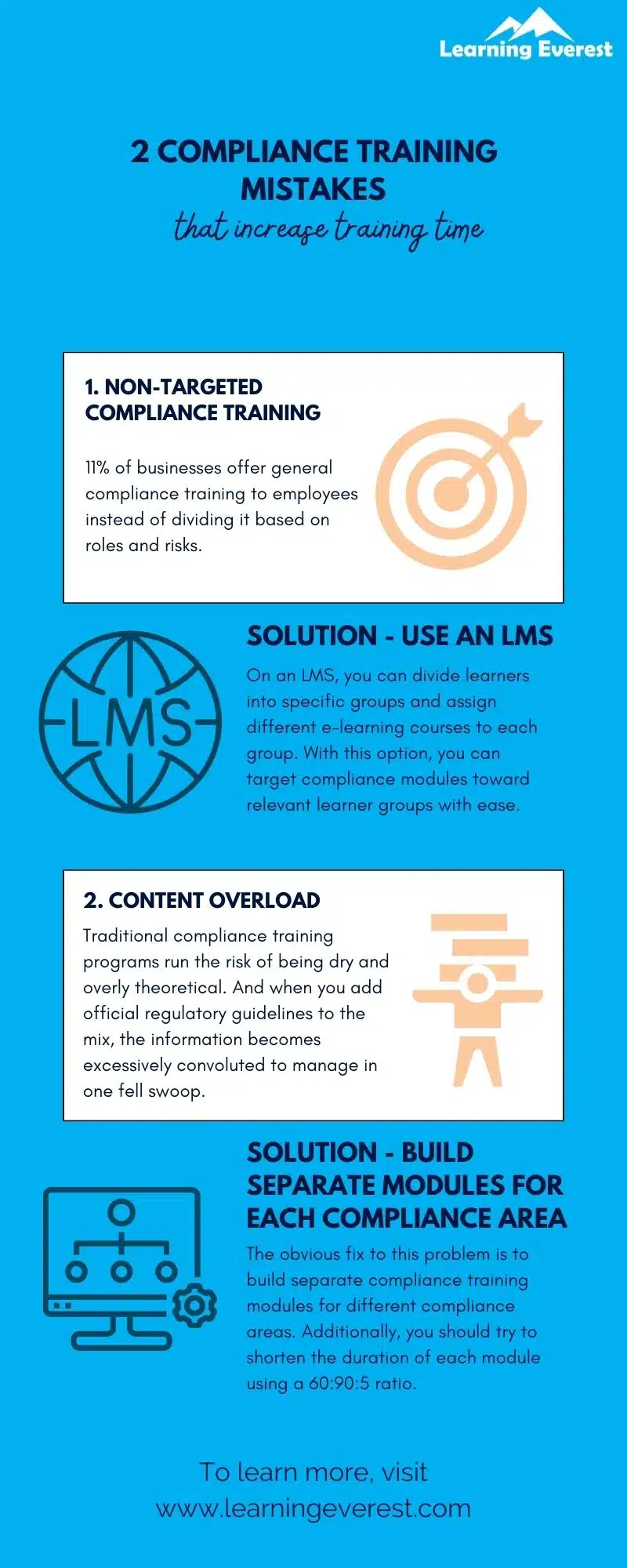With compliance training being such a routine aspect of businesses, organizations might sometimes fail to identify potential compliance training mistakes they’re making. Some of these oversights can increase compliance training time, costing companies hours they could have utilized elsewhere. This article will highlight 2 common compliance training mistakes and offer solutions to them so you can shorten compliance training time for your future compliance programs.
Table of Contents
Compliance Training Mistake #1: Non-Targeted Compliance Training
Businesses have various departments and posts that each come with special responsibilities and duties. For some industries, compliance risks might be the same for all employees, but for others, the risks vary from department to department.
According to the 2021 Compliance Training Benchmarking Report, 85% of businesses surveyed provided role and risk-specific compliance training to their employees. However, 11% offered general compliance training to employees instead of dividing it based on roles and risks. The most cited reasons for companies to forego specific compliance training were:
- Company systems not supporting targeted training
- Targeted training being too difficult to manage
- Lack of L&D or compliance personnel
Delivering targeted compliance training can significantly reduce training time because such programs ensure that learners must only finish modules that are useful to them. But achieving this is evidently a challenge for some organizations. Another layer to this problem is that organizations offering targeted compliance training also rated their satisfaction with the programs as being higher. In other words, targeted compliance training improved the quality of compliance training in the respondents’ eyes.
Solution – Use an LMS
A simple yet highly effective solution to this compliance training mistake is to use a learning management system (LMS).
These systems offer a wide variety of functionalities to enhance organization-wide training, from compliance to onboarding to job-specific skill modules.
On an LMS, you can also divide learners into specific groups and assign different e-learning courses to each group. With this option, you will be able to target compliance modules toward relevant learner groups with ease and even track metrics like completion, learner performance, feedback, etc.
Compliance Training Mistake #2: Content Overload
Content overload is another culprit that increases compliance training time. Traditional compliance training programs, even those delivered as e-learning, run the risk of being dry and overly theoretical. And when you add official regulatory guidelines to the mix, the information becomes excessively convoluted to manage in one fell swoop.
Additionally, overwhelming training programs interfere with learner retention. Multiple fields might be clubbed under the same module, whether they share a connection or not. And as discussed above, some training programs might try to tackle topics relevant to different groups of learners due to resource constraints.
All these factors make the training content heavier than needed and reduce training efficacy. One of the ground rules for making information stick is to make it meaningful for the target learners. Along with this, information that is presented in an engaging manner reduces the mental effort required to process and retain it.
Thus, content overload not only increases the time it takes to complete a training program but also negatively affects learner retention.
Solution – Build Separate E-learning Modules for Different Compliance Areas
The obvious fix to this problem is to build separate compliance training modules for different compliance areas.
Additionally, you should try to shorten the duration of each module. Ideally, the length of a compliance training course is between 20-25 minutes. To further improve learner engagement, it is optimal to follow a 60:90:5 approach, called the Interactive Compliance Training model:
- The 60 refers to adding an interaction every 60 seconds
- 90 seconds is the longest a video should run for
- Each individual topic should be 5 minutes long, averaging up to 4 – 5 topics per course or module
The 60:90:5 model also touches upon some important strategies for engagement. Interactivities and videos are some of the best tools to keep learners’ attention from wandering. Videos are also great ways to shorten complex topics and present information using examples, stories, case studies, diagrams, and animations.
Interactivities can also reduce course duration by allowing opportunities to present information using compact layouts such as click-to-reveal.
In the same vein as videos, other visual tools like pictures, icons, and graphs can summarize information in a matter of seconds. Humans process visual information more quickly than verbal information, thus, if something can be turned into a graphic instead of bullet points or paragraphs, you should go for it.
Infographics
Conclusion
By saving time on compliance training, you are doing both your organization and your employees a favor. Shorter modules mean that the company will lose lesser time on other activities and that employees will retain the information more effectively. Thus, businesses should re-assess their training modules routinely to see if they’ve fallen victim to the compliance training mistakes mentioned above.






